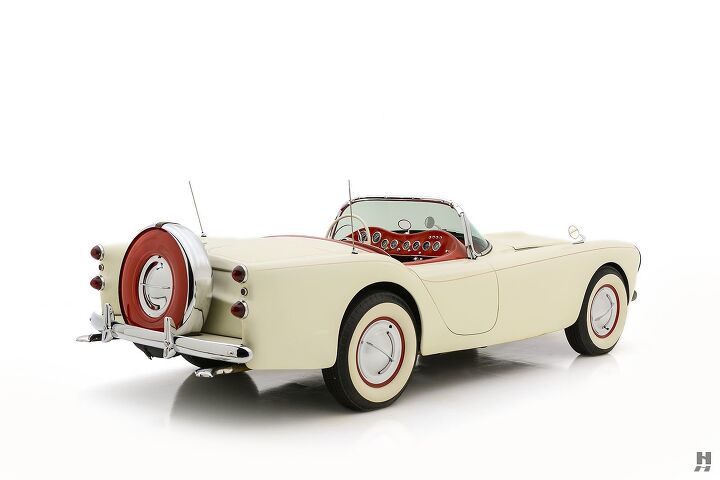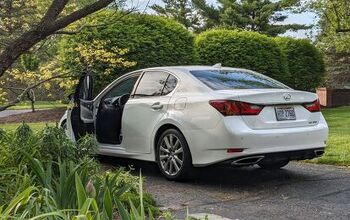Rare Rides: The 1954 Woodill Wildfire-Buick, Fiberglass and Fun-sized

Today’s Rare Ride was formerly unknown to your author. A brief boutique brand in the Fifties, Woodill went away long before most of you were even born. Let’s see if we can learn a bit more about this American take on the classic British roadster formula.
In the early Fifties, fiberglass started its spread across America as an easily workable, affordable material for use in the construction of sporty car bodies. The first of this new kind of sports car to enter production was the Glasspar G2, produced by Bill Tritt (a yacht maker) in 1949. In those days such roadsters were not offered by the major OEMs in Detroit, which opened a path for smaller shed-built, or “boutique” if you prefer, cars.
In short order, car dealers entered into small-scale production of their own takes on the idea created by the G2. That’s where Woodill entered the picture: A successful dealer of Willys trucks in California, he imagined his own G2-type vehicle. The roadster would of course be driven by Willys parts underneath. Woodill commissioned a Glasspar-built body from Tritt, then took his idea to Willys HQ, where he was quickly shot down. At the time Willys was in merger talks with Kaiser, and the Kaiser-Darrin roadster was already well into its development.
“I’ll do it myself then,” said Woodill. Shortly thereafter, the new Woodill Wildfire was ready for sale. Available at his dealership, the Wildfire used Willys mechanicals as planned; a low-power inline-six and manual transmission. Starting in 1952, the car was available in kit form, or as a complete car built by Woodill.
The Wildfire dumped the mostly unsuitable Willys engine for a Ford V8 at some point, but by then a little fiberglass competition had arrived – the Corvette. Corvette spelled the beginning of the end for piecemeal fiberglass cars from car dealers when it was introduced in 1953, as consumers eagerly threw their dollars at General Motors. The Wildfire remained on offer through 1958, with roughly 300 produced. Of that figure, 15 were sold as complete cars, and 285 as kits.
But today’s Rare Ride is an even rarer subset of those kit cars. In 1954 a few kits were purchased by a Buick dealer in California, Harry Clark. Clark put his own (fairly extensive) Buickification on the Wildfire. The front featured ’53 Buick lamps, and a modified form of a Chevy grille from the same year. He used a more curved windshield than the standard Wildfire. Clark also grabbed the rear fender molds from a ’53 Buick, and made them in fiberglass for his roadster. And perhaps most notably to add an upscale Buick vibe, a continental kit was attached at the rear. Chrome bumpers front and rear were donated by Ford, for some reason.
Power for these few examples was GM as well, in the form of the new 322 cubic inch Nailhead V8 from Buick. It was luxuriously matched with a Dynaflow automatic transmission, with floor-mount lever.
The extensive changes turned the Wildfire into a Wildfire-Buick, its only badging the Buick crest on the steering wheel. Perhaps the only one left today, this fully restored roadster asks $67,500. The joy of explaining what it is every time you park is thrown in for free.
[Images: seller]

Interested in lots of cars and their various historical contexts. Started writing articles for TTAC in late 2016, when my first posts were QOTDs. From there I started a few new series like Rare Rides, Buy/Drive/Burn, Abandoned History, and most recently Rare Rides Icons. Operating from a home base in Cincinnati, Ohio, a relative auto journalist dead zone. Many of my articles are prompted by something I'll see on social media that sparks my interest and causes me to research. Finding articles and information from the early days of the internet and beyond that covers the little details lost to time: trim packages, color and wheel choices, interior fabrics. Beyond those, I'm fascinated by automotive industry experiments, both failures and successes. Lately I've taken an interest in AI, and generating "what if" type images for car models long dead. Reincarnating a modern Toyota Paseo, Lincoln Mark IX, or Isuzu Trooper through a text prompt is fun. Fun to post them on Twitter too, and watch people overreact. To that end, the social media I use most is Twitter, @CoreyLewis86. I also contribute pieces for Forbes Wheels and Forbes Home.
More by Corey Lewis
Latest Car Reviews
Read moreLatest Product Reviews
Read moreRecent Comments
- Bd2 Lexus is just a higher trim package Toyota. ^^
- Tassos ONLY consider CIvics or Corollas, in their segment. NO DAMNED Hyundais, Kias, Nissans or esp Mitsus. Not even a Pretend-BMW Mazda. They may look cute but they SUCK.I always recommend Corollas to friends of mine who are not auto enthusiasts, even tho I never owed one, and owned a Civic Hatch 5 speed 1992 for 25 years. MANY follow my advice and are VERY happy. ALmost all are women.friends who believe they are auto enthusiasts would not listen to me anyway, and would never buy a Toyota. They are damned fools, on both counts.
- Tassos since Oct 2016 I drive a 2007 E320 Bluetec and since April 2017 also a 2008 E320 Bluetec.Now I am in my summer palace deep in the Eurozone until end October and drive the 2008.Changing the considerable oils (10 quarts synthetic) twice cost me 80 and 70 euros. Same changes in the US on the 2007 cost me $219 at the dealers and $120 at Firestone.Changing the air filter cost 30 Euros, with labor, and there are two such filters (engine and cabin), and changing the fuel filter only 50 euros, while in the US they asked for... $400. You can safely bet I declined and told them what to do with their gold-plated filter. And when I changed it in Europe, I looked at the old one and it was clean as a whistle.A set of Continentals tires, installed etc, 300 EurosI can't remember anything else for the 2008. For the 2007, a brand new set of manual rec'd tires at Discount Tire with free rotations for life used up the $500 allowance the dealer gave me when I bought it (tires only had 5000 miles left on them then)So, as you can see, I spent less than even if I owned a Lexus instead, and probably less than all these poor devils here that brag about their alleged low cost Datsun-Mitsus and Hyundai-Kias.And that's THETRUTHABOUTCARS. My Cars,
- NJRide These are the Q1 Luxury division salesAudi 44,226Acura 30,373BMW 84,475Genesis 14,777Mercedes 66,000Lexus 78,471Infiniti 13,904Volvo 30,000*Tesla (maybe not luxury but relevant): 125,000?Lincoln 24,894Cadillac 35,451So Cadillac is now stuck as a second-tier player with names like Volvo. Even German 3rd wheel Audi is outselling them. Where to gain sales?Surprisingly a decline of Tesla could boost Cadillac EVs. Tesla sort of is now in the old Buick-Mercury upper middle of the market. If lets say the market stays the same, but another 15-20% leave Tesla I could see some going for a Caddy EV or hybrid, but is the division ready to meet them?In terms of the mainstream luxury brands, Lexus is probably a better benchmark than BMW. Lexus is basically doing a modern interpretation of what Cadillac/upscale Olds/Buick used to completely dominate. But Lexus' only downfall is the lack of emotion, something Cadillac at least used to be good at. The Escalade still has far more styling and brand ID than most of Lexus. So match Lexus' quality but out-do them on comfort and styling. Yes a lot of Lexus buyers may be Toyota or import loyal but there are a lot who are former GM buyers who would "come home" for a better product.In fact, that by and large is the Big 3's problem. In the 80s and 90s they would try to win back "import intenders" and this at least slowed the market share erosion. I feel like around 2000 they gave this up and resorted to a ton of gimmicks before the bankruptcies. So they have dropped from 66% to 37% of the market in a quarter century. Sure they have scaled down their presence and for the last 14 years preserved profit. But in the largest, most prosperous market in the world they are not leading. I mean who would think the Koreans could take almost 10% of the market? But they did because they built and structured products people wanted. (I also think the excess reliance on overseas assembly by the Big 3 hurts them vs more import brands building in US). But the domestics should really be at 60% of their home market and the fact that they are not speaks volumes. Cadillac should not be losing 2-1 to Lexus and BMW.
- Tassos Not my favorite Eldorados. Too much cowbell (fins), the gauges look poor for such an expensive car, the interior has too many shiny bits but does not scream "flagship luxury", and the white on red leather or whatever is rather loud for this car, while it might work in a Corvette. But do not despair, a couple more years and the exterior designs (at least) will sober up, the cowbells will be more discreet and the long, low and wide 60s designs are not far away. If only the interiors would be fit for the price point, and especially a few acres of real wood that also looked real.







































Comments
Join the conversation
Looks bad from the rear but still an interesting car . To bad about the DynaSquish box, you have to suffer driving one to fully grasp how awful they are . -Nate
The tail lights look like those on a 53 Buick. Looks like they reached into the parts bin for 53 Buicks.